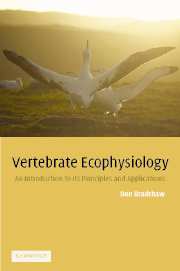Book contents
- Frontmatter
- Contents
- Introduction
- 1 Homeostasis: a fundamental organising paradigm in ecophysiology
- 2 Stress: the concept and the reality
- 3 Basic methods used in ecophysiological studies
- 4 Turnover methodology: theory and practice
- 5 Case studies of stress: incidence and intensity
- 6 Survival in deserts
- 7 Torpor and hibernation in cold climates
- 8 Marine birds and mammals
- 9 Conclusion
- Appendix 1 Population estimation methods
- Appendix 2 Estimation of food intake in Tiliqua rugosa
- Appendix 3 Simultaneous measurement of sodium and potassium concentration in plasma or urine using the IL 143 digital flame photometer
- Appendix 4 Determination of plasma urea nitrogen
- Appendix 5 Radioimmunoassay of testosterone in plasma
- Appendix 6 Preparation of ‘stripped plasma’
- Appendix 7 Radioimmunoassay of testosterone in faeces
- Appendix 8 The comparative method
- Appendix 9 Basic turnover equations
- References
- Index
9 - Conclusion
Published online by Cambridge University Press: 05 June 2012
- Frontmatter
- Contents
- Introduction
- 1 Homeostasis: a fundamental organising paradigm in ecophysiology
- 2 Stress: the concept and the reality
- 3 Basic methods used in ecophysiological studies
- 4 Turnover methodology: theory and practice
- 5 Case studies of stress: incidence and intensity
- 6 Survival in deserts
- 7 Torpor and hibernation in cold climates
- 8 Marine birds and mammals
- 9 Conclusion
- Appendix 1 Population estimation methods
- Appendix 2 Estimation of food intake in Tiliqua rugosa
- Appendix 3 Simultaneous measurement of sodium and potassium concentration in plasma or urine using the IL 143 digital flame photometer
- Appendix 4 Determination of plasma urea nitrogen
- Appendix 5 Radioimmunoassay of testosterone in plasma
- Appendix 6 Preparation of ‘stripped plasma’
- Appendix 7 Radioimmunoassay of testosterone in faeces
- Appendix 8 The comparative method
- Appendix 9 Basic turnover equations
- References
- Index
Summary
The preservation of the Earth's fast-disappearing biodiversity is one of the major preoccupations of biologists today. One may take Australia as a typical example. The continent was colonised by the Europeans a little over 200 years ago, and 200 species have become extinct in that short time – one species per year – which is a rate greater than that recorded in any other country or habitat, including the Amazonian rain forests. The major reason for this has been the destruction and modification of the habitat such that the indigenous animals are no longer able to survive. In Australia, introduced predators (cat, fox, dog) and competitors (sheep, cow, rabbit) have also played a part in exterminating vulnerable marsupials, but whatever the agent, humans must shoulder the ultimate responsibility.
How can ecophysiology help to stem this tide of extinction? Hopefully, by providing us with precise details of how animals manage to survive in their diverse environments before they become extinct, and by pinpointing aspects of their biology where they are particularly vulnerable. Often when individuals of a species become so rare as to be judged ‘threatened’ or ‘vulnerable to extinction’ it is very difficult to reverse a trend that has perhaps been in action but gone unnoticed for decades. The western swamp tortoise, Pseudemydura umbrina, is a good example. This is a small fresh water tortoise first collected in Western Australia in 1839 and thought to be extinct until a schoolboy brought a live specimen into the WA Museum in 1953.
- Type
- Chapter
- Information
- Vertebrate EcophysiologyAn Introduction to its Principles and Applications, pp. 198 - 202Publisher: Cambridge University PressPrint publication year: 2003



